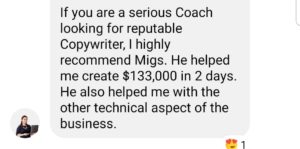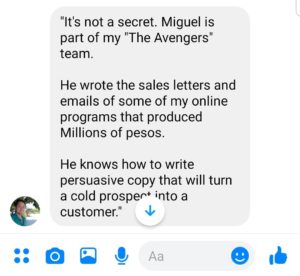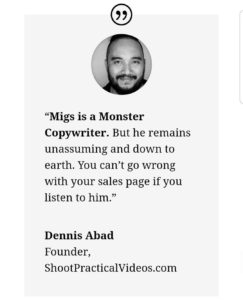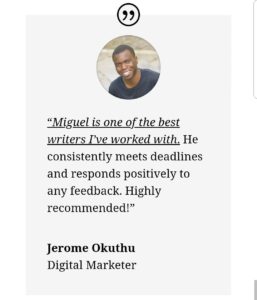Ever wonder how some writers and marketers have the ability to write 2,000-3,000 words at will?
Not only that, but their posts are also compelling and share-worthy.
The kind of blog posts you’re proud to finish reading. The kind you’d gladly post on Facebook…
…because you know it will make you seem smarter.
Don’t you wish you have that writing skill?
(I’m almost certain you do.)
Almost every marketer and business owner I know wants that. They want to write more emotionally-compelling 2,000-word blog posts
I mean, who wouldn’t?
According to a recent study, readers think long-form posts have more value. Google also thinks longer blog posts are more valuable.
Look at the average word count of blog posts in the #1 spot…

Image Source: Backlinko.com
Unfortunately, most of us don’t know where to start.
That’s why I’m going to share with you a framework I’ve used OVER and OVER again for my clients.
I first heard this on the Smart Passive Income Podcast. Ray Edwards, a 7-figure copywriter, shared his 7P Framework for writing blog posts.
At first, I didn’t think much of it. I thought this was one of those frameworks/acronyms that only worked for the person who created them.
But after seeing it everywhere, I realized Ray was on to something.
You’ll see the elements of 7P Framework being used in popular blogs like Neil Patel’s, Brian Dean’s and Pat Flynn’s.
It’s been used over and over again…
Contents [hide]
What’s the 7P Framework?
The 7P Framework is an outline that will help you write detailed long-form blog posts your target audience will LOVE to read.
The 7 P’s in the Framework are:
- Provoke
- Problem
- Personal
- Promise
- Proof
- Proposal
- Prompt
Answering these seven P’s can help you write longer posts. If you could write at least 100 words under each P, that’s already 700 words.
Imagine writing 200 words, 300 words, 400 words, 500 words under each P…
You’ll have a 2,000-word blog post in no time.
The second and most important benefit of this framework is that it FORCES you to perform deep research.
You won’t create generic blog posts.
You’ll write blog posts that will build your authority and secure your position in your industry.
You’ll create blog posts that your audience CAN’T IGNORE.
So without further delay, let’s start…
How Does the 7P Framework Work?
You can follow the sequence as outlined above or you can mix it up. Depends on you.
But if you’re a beginner, I highly suggest you stick with it.
First, you need to…
(1) Provoke
Write opening sentences that provoke emotions, curiosity, or both. It doesn’t have to awe or shock.
The purpose of these sentences is to hook your audience from the start. After reading the first few paragraphs, they feel that they just have to know more. These are the kinds of sentences that will make your reader nod in approval or shrug with disapproval. Or, make them happy, sad, jealous, envious, nostalgic, enthusiastic, excited or all of the above if you can.
Jon Morrow, one of the most visceral writers I follow, is the leading authority in this.
He writes opening statements that always poke your emotions or provoke curisoity.
Look at some of his work:
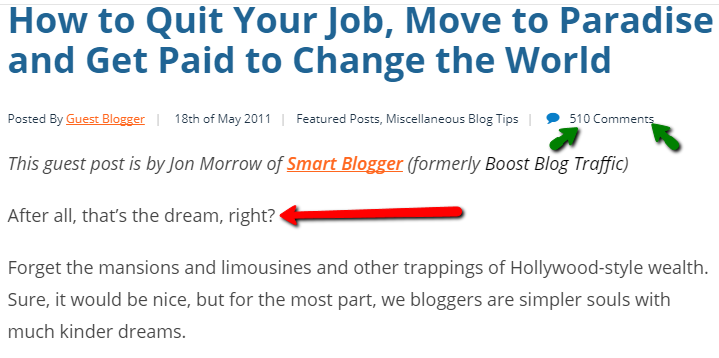
This post got 510 comments and it’s the most popular blog post in ProBlogger.com.
Here’s another example from Brian Dean (founder of Backlinko.com) that provokes curiosity…
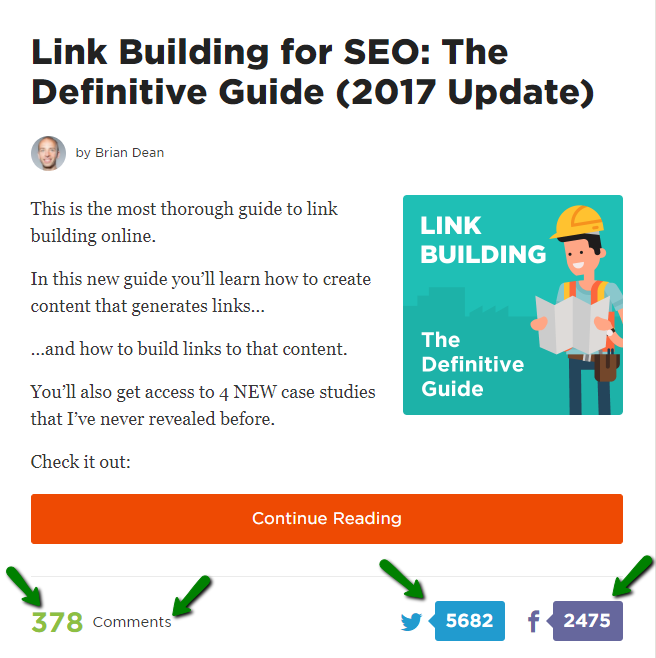
As you can see, both blog posts had high engagement and were shared thousands of times. These are just two examples. Try to revisit a blog post you love or bookmarked. I guarantee you almost all of them have great openings.
Of course, you have to keep it up. Your content needs to be outstanding, actionable, and solve a deep problem.
You don’t have to be a master persuader to write openings like these…
You simply need to have a deep understanding of your audience’s problems, dreams, ambitions — you know the things that keep them up at night.
And you can only do that through research and actually talk to them.
How to Write Opening Sentences that Provoke
There are many ways you can write an opening sentence that provokes. You’re only limited by your imagination.
However, there will be times you’ll draw blanks. You’ll hit a wall. Or, maybe experience writer’s block.
If that happens, use these frameworks:
1. An opening sentence that “INCLUDES.”
It is in our DNA to want to belong to a certain group. Our ancestors did it to survive. The more they were in a group, the better their chances of survival.
We carried that mindset until today. And that’s what you want to tap in this framework. In your opening sentence, you want to include your reader in a certain group.
For example:
“Are you a freelance writer that sucks at time management?”
“Do you hate iPhone apps? If you do, then this is for you.”
“Is this your first year freelancing?”
From the start, you’ll only get readers that will benefit from what you actually wrote. So more shares for you!
You’ll also repel the ones who won’t like your article. Because, in all honesty, it wasn’t for them in the first place.
2. An opening sentence that “EXCLUDES.”
This is the opposite of the first one (obviously)…
Remember in high school? You were separated according to a “status quo.”
The varsity players always hung out. So did the math geeks, comic book fans, cheerleaders, and choir members.
In high school, you already belonged to a certain group. And you probably loved it. I know I did.
However…
We always secretly wanted skills or attributes the other groups have, right?
You wished you were as strong or handsome as some of the popular kids. Maybe you were jealous your student body president was really smart.
Now, that’s the emotion you want to tap here. Jealousy. Envy. Thinking the world is “unfair” because they have something you don’t.
In this “Exclusion” opener, you’re describing what your readers want (but don’t have) that other people have.
For example:
“Isn’t it amazing how some bloggers are so confident on camera?”
“Some guys don’t seem to have a problem approaching beautiful women.”
“Don’t you wish you had Yvonne’s beautiful skin?”
An opener like that will make them internally say yes or make them feel an emotion…or both!
3. Write a story.
Now, this is by far the easiest way to open a blog post. It’s because you’re writing from memory. The words will naturally flow out of you.
You don’t need much research to pull this off.
However…
You need to be a visceral writer. Your story needs to be descriptive, detailed, and captivating at the same time. It should make your reader feel like they’re on the sidelines while the story is unfolding.
That means telling them what you saw, heard, felt, tasted, smelled, and how it affected you.
Do not over-think this. Just write. Add a few power words and descriptive words later.
The best stories are often the embarrassing ones. The stories you only tell close friends and family.
If you’re willing to do that, then go for it.
Here’s an example from Jon Morrow:
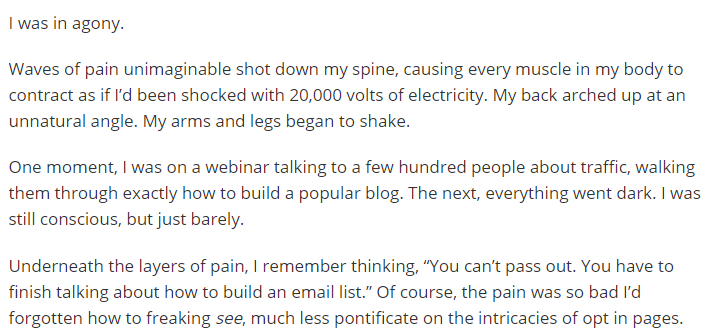
Stories are one of the best communication tools we have as marketers. The best marketers in the world are great storytellers. It’s because we can share our ideas without resistance.
So from time to time, write a story that provokes a response or emotion. You may just be surprised how well people receive it.
(2) State the Problem
Us, marketer, we’re problem solvers. We create products and services that make our customers’ and clients’ lives better.
Hopefully, you sell and market products and services that solve a problem, too. Not just to make money.
In every piece of content you write, you must solve at least one problem.
In this article, for example, I’m teaching you how to easily write 2,000-word blog posts using the 7P Framework.
Problem = can’t write 2,000 word blog posts
Solution = the 7P Framework
How about you?
What problem does your blog post solve?
Do your videos help viewers become more persuasive? Are your social media posts make followers become better at their jobs?
Find the problems you want to solve. Find the pain points you want to relieve or eliminate.
PRO TIP: If you can explain the problem better than your target audience can, you’ll slowly gain their trust.
Think about it.
If you had foot fungi, who would you rather talk to about it? Your neighbor who’s always great at tidying himself up?
Or, your former classmate you knew back in gym class had the same problem.
By explaining the problem better, you’ll be the former classmate. Not only that, but you’ll also establish common ground with your target audience.
And having “common ground” is where many good relationships start.
How to Find Your Target Market’s Problem
Insert the second P in the 7P Framework by answering “WIIFM?”
WIIFM means What’s in it for me?
Imagine your target audience is busy. They’re at the grocery, drinking Starbucks or eating lunch. They will not stop their busy lives for you.
They will IF they can get something out of it.
In the first few paragraphs, tell them you will help solve ONE PROBLEM.
This problem should be apparent in their lives. More importantly, you should show that solving this problem will eliminate a pain or avoid embarrassment.
Highlighting the positive benefits is good, too.
But people will take action more quickly if they know the solution will alleviate pain or avoid embarrassment.
(3) Tell Something Personal
Now, it’s time to inject personality into the blog post. Add your opinion, suggestions, recommendations, perspective…anything that adds “you” on the blog post.
This is what makes your post unique. No one can have the same perspective as you. They can’t copy “you.”
Tell a story. Share your experience.
Why do you think the way you do?
How did this topic change your life?
What did your friends think about this?
Just make sure anything you share is relevant to the blog post you’re writing. It has to connect with the overall flow of your post.
How to inject your Personality into your blog post
By the time you’re writing this, you’ll have already stated the problem. So tell something about the problem…in your perspective.
Have you experienced the problem? How did it affect your life?
Or, maybe your friend experienced it. Did he solve it? What did he do?
Like story openers, this is easy to do. You’re essentially writing from memory. In-depth research is unnecessary.
Another good thing about this?
It will be unique. No one experienced the same things you do.
WARNING: Do not get too caught up on this. The blog post is for your readers. Not you.
So write, don’t rant. Only include ideas you deem are beneficial to the post.
You have the provocative opening, a problem, and a story that ties everything up.
Now, you need something every marketing piece has…
(4) What’s Your Promise?
Promises get marketing materials read. Your sales letter, VSL, emails, blog posts, social media posts…everything…must contain a promise.
So should your in-depth, 3,000-word blog posts.
The promise is the ultimate benefit. What’s the ONE THING they will absolutely get after reading your humongous post?
In this post, for example, I promise you’ll be able to write compelling 2,000-word blog posts faster. There’s also a promise that you can use this in any niche.
What’s your promise?
What should you Promise?
According to Todd Brown, your promise needs to be emotionally compelling and focuses on only ONE BIG IDEA.
How can you make it emotionally compelling?
By learning the real benefits and the “faux benefits.”
In one of his blog posts, Clayton Makepeace differentiates the real benefits from the fake ones. He calls the fake ones “faux benefits.”
These are benefits we think we need but really don’t.
For example, learning Spanish can be a benefit.
But, be honest with yourself, how many times have you thought “I should learn Spanish” first thing in the morning?
Not much, right?
This is what you call “faux benefits.” The real benefit is that you’ll feel confident around your Spanish friends, talking in their native language.
When you visit Spain and see a gorgeous woman alone in a bar, you’re confident enough to approach her…because you can speak Spanish fluently. Thus, you’ll have a better chance of getting her number.
You see, the real benefits are connected to an emotion.
In our example, it’s avoiding embarrassment and confidence.
The emotion connected to this blog post? It’s confidence and assurance. After reading all of this, you’ll be confident enough to write a 2,000-word blog post and be assured it’s going to be great.
Before I can convince you of that, I need…
(5) Prove Your Claims
For me, Proof is the most important part of the 7P Framework. You need proof to back up your claims and promises.
Having proof elements in your blog posts will set you apart. You’re not one of those writers that just blogs about what they read. You actually took the time to make sure it’s correct. Most importantly, you’ll be more persuasive.
Proof demonstrates that what you’re saying is true and it works. You CAN NOT write an emotionally-compelling blog post without proof. If you don’t have proof yet, find them.
What kind of proof should you put in your blog posts?
…Actual examples, scientific research, anecdotes, case studies, social proof, third-party proof, celebrity endorsement, influencer endorsement…
Anything or anyone that VERIFIES what you’re saying works…not just once, not twice, but all the time if correctly implemented.
Having different types of proof gives your blog post legitimacy.
Your readers won’t also have “share-anxiety.” This is when your readers LOVE your post, but won’t share because it lacked proof.
The next time you’re writing a blog post ask yourself: does my blog post need more proof?
Maybe that’s the only reason your readers don’t share it.
How to use Proof in your blog post
Now, there are two approaches:
(1) You find proof first and then write a blog post about it
(2) You write a blog post and then find proof.
Option 1 is easier to do. Once you have solid proof — a case study, scientific research, celebrity endorsement — it will be easier to convince your readers your idea is right.
But to be completely honest with you, I write using the second approach from time to time.
And what happens is this: my blog post’s main idea and primary promise change every time I find more proof.
Why?
Sometimes the different types of proof I find don’t support my ideas and promises. I can’t edit the proof. They are facts. So I ended up completely reworking articles.
So my advice? Use approach #1. Find proof and then build an article around that.
Once you gather enough evidence and proof, you already have a convincing argument. Your readers are more welcome to your suggestions and recommendations.
That’s when you use the 6th “P” in this framework, which is…
(6) Propose the Next Action
After going through all the five P’s, your readers are probably asking themselves…
“Now that I know all of this stuff, what’s the next step?”
That’s where you come in.
You tell them your “proposal.”
You propose a solution, a new way of thinking, a better way of doing.
Do you want to change their current perspective? Give them detailed steps on what they should do next.
Are you selling a product? Tell them to buy your product because they’ll get XYZ outcome.
How to create an irresistible Proposal
Never start with you. Always start with your target audience.
Make sure your proposal TREMENDOUSLY BENEFITS them and it will alleviate their pain or solve their problem.
Finally, show them the pain of the problem outweighs the effort of following your proposal.
It doesn’t require much of them to do what you ask. And if they decide to follow it, they’ll gain 10X more of what they invested.
For example, you propose they opt-in to get your Cold Email Templates.
Benefit = not wondering if the cold email devalues you in the eyes of the prospect or not
Problem solved = not writing from scratch or taking hours to write one
Effort = it takes minutes to write and send. If it works, they’ll get a new lead or client.
So, what’s your proposal?
Because it doesn’t end there.
Once you told them what to do, you need to explain HOW they should do it.
That’s why you need the 7th and final “P”….
(7) Prompt Readers Into Action
Prompt your reader into action. This is your call-to-action.
Tell them EXACTLY what they should do, what to expect, and what will happen if they do what you propose.
Easy, right?
But sometimes marketers forget this.
PRO TIP: Have ONE call-to-action per blog post. Two or more and you’ll risk the chance of complicating it for them.
Make it simple.
If you’re going to ask me, always ask them to either comment or opt-in. Don’t ask to share the blog post. If it’s good enough, they will share it.
It’s normal for us to share great content. We do it all the time. It’s also really easy because it only takes one click. However, it takes more time and effort to write a thoughtful comment or opt-in to your list.
So, that’s the 7P Framework…
Can you see yourself using this framework to write blog posts?
I know it can be difficult…even overwhelming. But if you stick to this process, there is NO WAY you’ll write a “dud.”
This outline will force you to create deep, meaningful, and well-researched posts. Do this long and often enough and you’ll see yourself write in-depth content that will establish you as an authority in your industry.
How about you? Do you use any frameworks when writing? Do you have writing prompts? Let me know by leaving a comment below.




